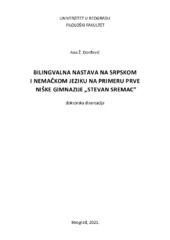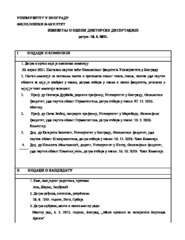Приказ основних података о дисертацији
Bilingvalna nastava na srpskom i nemačkom jeziku na primeru Prve niške gimnazije "Stevan Sremac"
Bilingual classes in Serbian and German in "Stevan Sremac", the First grammar school of Niš
| dc.contributor | Durbaba, Olivera | |
| dc.contributor | Jazbec, Saša | |
| dc.creator | Đorđević, Ana | |
| dc.date | 2021-07-16 | |
| dc.date.accessioned | 2022-02-08T12:01:08Z | |
| dc.date.available | 2022-02-08T12:01:08Z | |
| dc.identifier | http://eteze.bg.ac.rs/application/showtheses?thesesId=8484 | |
| dc.identifier | https://fedorabg.bg.ac.rs/fedora/get/o:24982/bdef:Content/download | |
| dc.identifier | http://vbs.rs/scripts/cobiss?command=DISPLAY&base=70036&RID=53014537 | |
| dc.identifier.uri | https://nardus.mpn.gov.rs/handle/123456789/18914 | |
| dc.description | U ovom radu analizira se model bilingvalne nastave na srpskom i nemačkom jeziku, koji se primenjuje u Prvoj niškoj gimnaziji „Stevan Sremac”. Na osnovu rezultata prikupljenih nakon terenskog istraživanja, predstavljaju se aktuelni problemi i izazovi sa kojima se škola, nastavnici i učenici1 susreću u radu. Pored teorijskog okvira bilingvalne nastave, doktorska teza obuhvata аnаlizu rezultаtа testirаnjа receptivnih jezičkih veštinа (rаzumevаnje pisanog teksta) nа primerimа DSD testova za nivo znanja A2/B1, kаo i stručnih tekstovа iz srpskog jezika i književnosti, istorije, muzičke i likovne kulture. Testirani su učenici Prve niške gimnаzije koji usvajaju nemački jezik u okviru bilingvalne nastave (eksperimentalna grupa), dok su kontrolnu grupu činili učenici koji prate nastavu nemačkog jezika po tradicionalnom školskom programu, kao i učenici filološkog smera, koji nastavu nemačkog jezika takođe pohađaju po tradicionalnom školskom programu, ali sa povećanim fondom časova. Najbolje rezultate na testiranju postigli su učenici bilingvalnog smera, što je i dokazano empirijski, deskriptivnom i kvalitativno-kvantitativnom analizom. U okviru doktorske teze, proučavaju se i efekti primene bilingvalne nastave nemačkog jezika na personalne karakteristike učenika. Teza obuhvata i povezanost upotrebe interneta, televizije, aplikacija i igara na nemačkom jeziku sa rezultatima iz nemačkog jezika učenika bilingvalnog, filološkog i društveno-jezičkog smera. Rezultati istraživanja su potvrdili povezanost personalnih karakteristika učenika sa njihovim postignutim rezultatima iz nemačkog jezika. Pozitivan efekat dala je primena ovih dodatnih metoda za učenje jezika nezavisno od obrazovnog smera učenika. | sr |
| dc.description | This paper analyses the model of bilingual teaching in Serbian and German, applied at “Stevan Sremac”, the First Grammar School of Niš. The current issues and challenges faced by the teachers and students of the school during their work are presented on the basis of the results collected after the field research.12 In addition to the theoretical framework of bilingual teaching, the doctoral thesis includes the analysis of the results of assessing receptive language skills (reading comprehension) on the examples of DSD tests for the A2/B1 knowledge level, as well as professional texts in the fields of literature, history, music and art. The testing involved the students of the First Grammar School of Niš who learn German as part of their bilingual classes (experimental group), while the control group consisted of students who attend German language classes according to the traditional curriculum, as well as students of the philology class, who also attend German language classes according to the traditional curriculum, but with a greater number of classes. The best test results were achieved by the bilingual students. This was proven empirically, and by employing a descriptive and qualitative-quantitative analysis. The effects of the implementation of bilingual teaching of the German language on the personal characteristics of students are also studied in the doctoral thesis. In addition, the thesis includes the connection between the use of the Internet, television, applications and games in the German language and the German language test results realized by the students of bilingual, philological and social science and language classes. The results of the research confirmed the connection between the personal abilities of the students and their German language test results. The use of the Internet, watching television, using applications and games in German, as well as learning the language outside of the students’ class, yielded a positive effect. | en |
| dc.format | application/pdf | |
| dc.language | sr | |
| dc.publisher | Универзитет у Београду, Филолошки факултет | |
| dc.rights | openAccess | |
| dc.rights | BY-NC-ND | |
| dc.source | Универзитет у Београду | |
| dc.subject | bilingvalna nastava, CLIL(iG), DSD testovi, nemački kao strani jezik, testiranje, jezičke receptivne veštine, kompetencije BICS i CALP, kritička analiza, preporuke | sr |
| dc.subject | bilingual teaching, CLIL(iG), DSD tests, German as a foreign language, testing, language receptive skills, BICS and CALP competencies, critical analysis, recommendations | en |
| dc.title | Bilingvalna nastava na srpskom i nemačkom jeziku na primeru Prve niške gimnazije "Stevan Sremac" | sr |
| dc.title | Bilingual classes in Serbian and German in "Stevan Sremac", the First grammar school of Niš | en |
| dc.type | doctoralThesis | |
| dcterms.abstract | Ђорђевић, Aна; Bilingual classes in Serbian and German in "Stevan Sremac", the First grammar school of Niš Bilingvalьnoe obučenie na serbskom i nemeckom яzыkah na primere Pervoй nišskoй gimnazii “Stevan Sremac”; | |
| dc.identifier.fulltext | http://nardus.mpn.gov.rs/bitstream/id/142064/Izvestaj_Komisije_12057.pdf | |
| dc.identifier.fulltext | http://nardus.mpn.gov.rs/bitstream/id/154892/disertacija.pdf | |
| dc.identifier.rcub | https://hdl.handle.net/21.15107/rcub_nardus_18914 |



